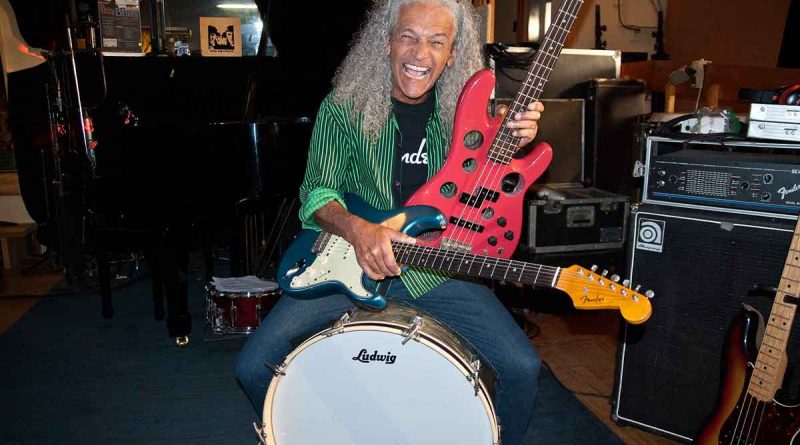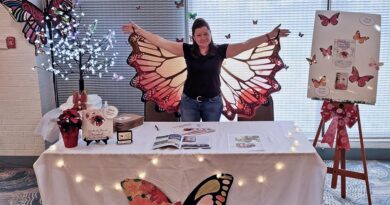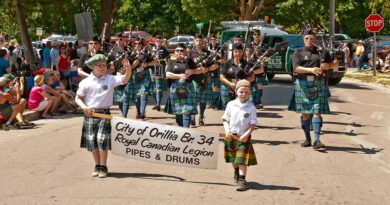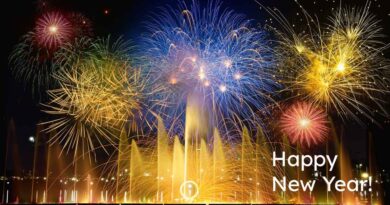Good Clean Sound
By John Swartz
Orillia and area had only one studio where musicians could record music, but in the last couple years two more have been established and one more is soon going to be up and running. This is part 2 of the series.
Steven Henry gives music lessons at his Warminster studio to people who want to learn to play guitar, ukulele, banjo, bass guitar or sing. He plays those instruments very well and has been known to do a little cello playing too, but he doesn’t give cello lessons.
“Some people play the cello, some people own the cello,” Henry said.
He could almost train a whole band, except for the one instrument missing from the above list. Many people know him as a great guitarist, singer and songwriter, but he’ll tell you his first love and strength is drums.
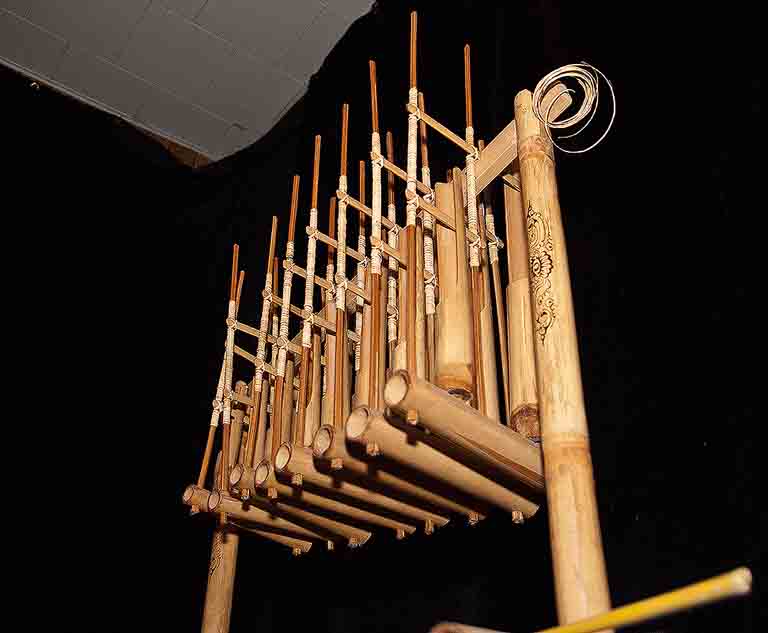
An Indonesian Angklung
When it comes to recording drums you have to travel far to find anyone who can do a better job than Henry will do. His Vital Sound Recording Studio has been operating for 30 years and its full of all the instruments mentioned, plus a Hammond A100 organ – with two Leslie Speakers (the A100 is the same under the hood as the legendary B3, except it was designed for home use, it’s more compact, and has a built in preamp which the B3 does not, bottom line they can sound the same with the right pair of hands playing), a baby grand piano, three sets of drums, plus a bunch of hand drums and assorted percussion ging gongs – including one he doesn’t know the name of that looks almost like a small marimba hybrid (which turns out to be an Indonesian gamelan instrument called the angklung).
Then there’s the rack of guitars and amps lined up in a corner.
“An old 80s Marshall (amp). You can’t get these anymore. I’ve got two of them. I got lucky. A 1950 National with a suitcase handle, 1962 Ampeg Reverb-o-Rocket, and the prize – a 1955 Fender Champ,” Henry listed. Of course Leo Fender was building amplifiers long before he designed and built the Stratocaster guitar, even though he couldn’t play the guitar. “He was in the amplifier business for a while, an electronics guy. He sure had good ears.”
It’s hard to see the control room for all the instruments, yet the main room has plenty of space for musicians to be comfortable. A big picture window on an interior wall gives away where the control room is; up a short flight of stairs, through the kitchen and turn right. There’s plenty of room in there too, and the length of wall with the window features a 32 channel Soundcraft mixing board.
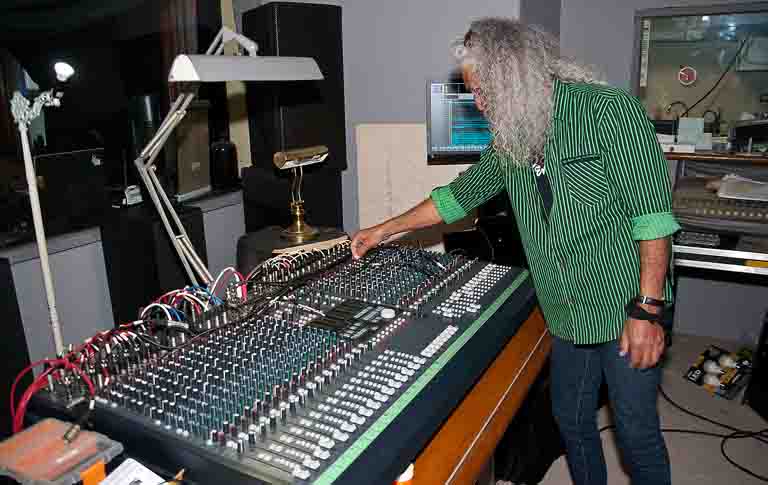
“It’s a $30,000 board when it was new. It’s about 30 years old now. It sounds great,” said Henry. What’s missing is a rack, or racks, of sound processing hardware. Everything leaves the board and goes into what is literally a black box.
“I’ve got the best recorder. I’ve used their recorders for 20 years,” he said. In a few minutes he would back that up by playing a recent recording.
“When my reel to reel went down I didn’t know what I was going to do because I was not ready to go into the digital field at all. I didn’t want to touch it, didn’t like how it sounded, and then this guy had a Radar recorder. It (an advertisement) said 24 track recorder for sale, $1500 dollars, digital. I thought, well, let’s go have a look at it. He turned it on, played me some stuff and I went, “are you kidding? That sounds like a tape machine.” It was very fat and warm.”
It, like many things Henry has acquired for his studio, is a very expensive machine, yet, as the stories continue, for most of the gear Henry was in the right place at the right time and got a lot of his gear for, well, a song. The recorder he has uses three sound cards, not one like most people have – if they have a sound card that isn’t built into their motherboard – or two like some industry standard gear, but three.
“The funny thing is, everybody I told about this said, “I never heard of it,” and “Steven, if you don’t have Pro Tools, you’re not even in the game.” Three years ago Daniel Lanois bought three of these for his studio and everybody’s going, “Oh yeah, Radar.” It’s just insane,” he said.
It turns out Radar 6 recorders are in most of the top studios around the world, now. Henry was just ahead of the curve. When time came to expand so he could record more than 3 average length songs before moving the files out of the machine to something else, he got lucky again.
“I found a teaching school in Toronto, I want to say RCF recording facility in Toronto, they were selling a Classic 24 for $3,000. I immediately got on the phone, “really? Are you sure it’s a Radar?” said Henry.
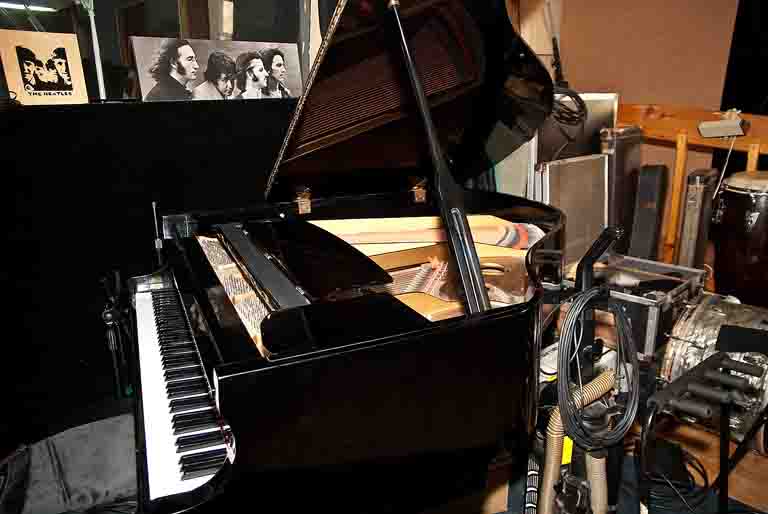
“Yup.”
“It’s got swappable hard drives?”
“Yup, 120 gig drives.”
“I’m going, “I’m on my way down, I want to have a look at it””
After ten years it was time to upgrade the computer running the system; time for another story.
“I called Radar because they are in Vancouver. Went down, met the guy (Barry Henderson) who started the company, the brains behind the company, the guy who’s actually got digital recording math down properly, and (he) took a liking to me. He goes, “Steven you’ve got the nicest sound cards, so let’s take those, I’ll get you a new hard drive, a whole new computer, and we’ll just stick your sound cards back in,”” Henry recalled. He got the agreed upon payment, went to pick up his refurbished machine, and then:
“That’s in American funds. right?” Henderson said to Henry. Oops.
“I went, ”oh my God. I don’t have that kind of money.””
“I’ll do it on par for you.” Henderson said.
“He took it,” Steven said.
The big difference between Henry’s recording machine and all the other computer based systems is it just records, very well, without bells and whistles. Henry played a song and the noise floor was so low, we were standing above it. The instruments sounded like they were being played in front of us. It was so clean. And all the instruments in the recording were played by Henry.
“Slow and Thoughtless right now,” he said it was called, “because I wasn’t thinking much about it.” Henry has several recording of original tunes he’s preparing for an album, some of them will be covers of songs like Someday We’ll Be Together (the Supremes) and To Sir With Love (Henry is known to give a Motown treatment to cover tunes, even the ones that didn’t come from the Motown catalogue). Again he played all the instruments. Asked who the women were on the Supremes tuned was met with – what women? He’s got vocal range and chops too.
While the Radar can have other software, like Pro Tools and such added, Henry prefers a few pieces of hardware, not software, compressors, reverbs and other effects, he patches into the mixing board.
“I hardly use them. I just want to record with it (the Radar). I don’t have the internet hooked up to it and this and that,” he said. His forte is capturing instruments and voices as purely as can be done.
“That’s the other thing, when you are recording other people, their (playing) levels are so up and down because they are not used to recording. After 30 years you get to realize, hit the kick drum the same all the time,” he said. Well, except for some kinds of music, like jazz when dynamic control is part of the performance, not poor playing technique.
“You want rock dynamics too, but it’s not from nothing to big bang.”
Of course, the recorder is a computer, so he can do some cutting and pasting, when he needs to.
“There’s a little bit of editing. I’m going to buy a Cubase program one of these days when I grow up and I can afford it,” Henry said.
All the exposition so far is to illustrate the capability Henry brings to a recording. Things seldom found in the same person – a musician with boatloads of talent and great working knowledge of the recording gear (he can break out a soldering iron and repair the electronics too). In fact he has been working on music files a Toronto area musician recorded elsewhere just to add drums to.
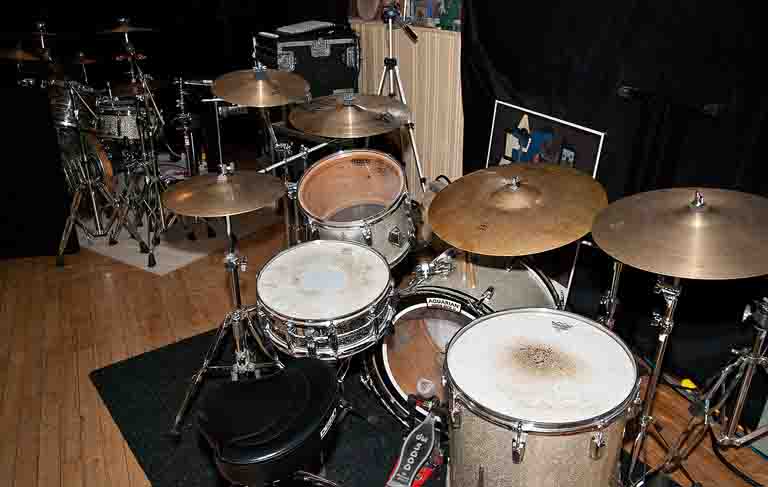
“A lot of people will record drums and then they’ll pull in drum sounds they want it to sound like. I’m about the drum and the room. This is real drum sounds. I can give you the John Bonham kit drum (sound) if you like, to me it’s not about that. It’s about capturing the sound of your drums and having acoustic drums,” he said.
“I’ve had people say to me all the time when I’m mixing, “the drums are ringing.” They’re drums, they are supposed to ring. If you start taking that away, they’re not drums anymore.” The sound goes straight into the mic, right to the board and then the recorder, no gates or other effects added.
“Everything is wide open. I’m about the real sound. If the drums are tuned properly and they are played properly – I have had guys come in with DW drums, it sounds like #&*^. They’re the most expensive, beautiful sounding drums you could ever buy, they hit them too hard and kill the tone.”
He does the same thing with guitars, no direct inputs to the board, just mic the amps.
“Sometimes I’ll put two microphones up. I’ll put one up close and one ten feet away.” When it comes to vocals, all the attention to detail so far exhibited takes a turn. One would expect a high end mic like a Neumann, which appears to be what is mounted on a stand. But it’s not. It’s a Rode, a fairly new brand name, but one whose microphones have virtually taken over sound production, especially in-the-field kinds of recordings like in television, because they get results, and they are not nearly as expensive as other industry standard mics.
“If I had an SSL board, a Neumann that would be beautiful, but without a $300,000 mixing console the Neumann doesn’t work,” said Henry.
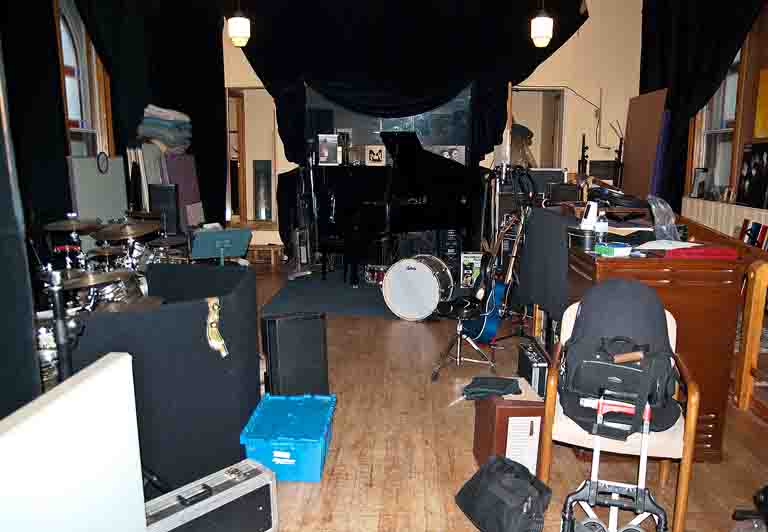
So who does he record? He did the Rockdogs and The Ruins back in the day, but lately , when he’s not working on his own music, he tends to stick with projects for people he knows. Some have used the studio for rehearsals, as Bleeker did a month ago to get ready for a series of performance date.
“Smaller projects. People that understand they can’t come here and walk out with a finished product. They can come here to record all their tracks, then they have to take it somewhere and have it mixed. I don’t want to do that. Mixing, it’s a personal taste and most of the time you’ve got somebody behind you going, “I need a little more of this, wait, I need a little more this” and all they are doing is volume chasing. They have no clue of really what they want.”
And by the way, he gives drum lessons too.
(Photos by Swartz – SUNonline/Orillia)
![]()



![]()

